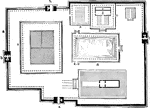Clipart tagged: ‘pagoda’

Pagoda
"Japanese pagodas are similar to those of China, and even more elaborately carved." —D'Anvers,…

Pagoda
All these buildings are of a pyramidal shape, with vertical stages, which are separated by curved roofs…

Ground Plan of the Pagoda at Chillimbaram
Nothing reliable can by adduced concerning the age of the existing structural temples of India, which…
Pagoda Column
All these buildings are of a pyramidal shape, with vertical stages, which are separated by curved roofs…

Entrance to a Pagoda
Nothing reliable can by adduced concerning the age of the existing structural temples of India, which…

Pagoda Moulding
All these buildings are of a pyramidal shape, with vertical stages, which are separated by curved roofs…
Pilaster, Temple of Chillimbaram
All these buildings are of a pyramidal shape, with vertical stages, which are separated by curved roofs…

Pagoda, Shoemadoo
"The pagoda forms a very prominent feature in the architecture of Further India. A specimen of the Burmese…

Temple, Tanjore
"The great pagoda at Tanjore is by far the grandest temple in India, resting on a base 83 feet suare,…

Temple of Chillimbaram Entrance Elevation
All these buildings are of a pyramidal shape, with vertical stages, which are separated by curved roofs…